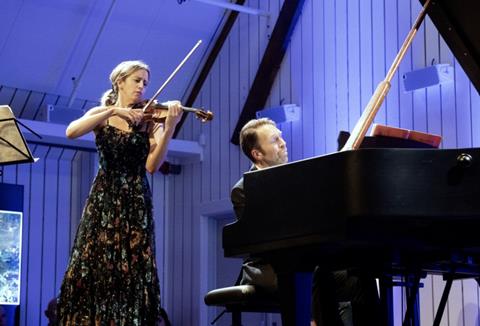Harriet Smith finds that rain certainly didn’t stop play at Leif Ove Andsnes’s inspiring annual Norwegian gathering from 7–11 August 2024

This year’s Rosendal Festival – an annual gathering in which pianist Leif Ove Andsnes lures musical friends and a keen international audience to share the quiet splendour of its western Norway setting – took as its theme ‘Contrasts’. It was a suitably loose concept that allowed Andsnes to set a string of works by Hungarian composers alongside Bach’s music.
Fittingly enough, the opening concert featured Bartók’s Contrasts: a lively performance that showcased three musicians who were recurring fixtures in the festival, violinist Florian Donderer, clarinettist Wenzel Fuchs and pianist Zlata Chochieva. If the wind player was at times a touch reticent, overall this was an interpretation that revelled in the piece’s anarchic qualities, culminating in the wild dance of the third movement.
But the best was saved till last: Bartók’s First Violin Sonata, with Vilde Frang making the first of only two appearances here (it would have been good if she could have stayed for more), with Andsnes at the piano. And what a potent duo they proved, surmounting the piece’s difficulties with ease, imbuing this large canvas with a real in-the-moment reactivity, explosive energy one moment, an almost vocal quality to the recitative-like writing the next; Frang was never afraid to trade beauty of sound with potent acerbity when the music demanded it.
The Hungarian strand was explored in a compelling talk by Rachel Beckles Willson, and musically there was much to hold the attention over the festival’s packed schedule. Kodály’s Duo was one highlight, with Donderer joined by cellist Victor Julien-Laferrière for a reading that demonstrated that this is a conversation as much as a showpiece, seemingly delighting in its many technical challenges, the bare octave D at the close simultaneously hard-won and triumphant.
The Paris-based Agate Quartet, which was founded the same the same year as the festival – 2016 – made a great impression in Bartók’s Sixth Quartet and Mozart’s Clarinet Quintet, but even more memorable was its fearless way with Ligeti’s single-movement First String Quartet, which pulsed with the composer’s trademark elements from the off, a scintillating mix of subversion, ebullience and absolute fun. Clearly a lot of rehearsal time had gone into a performance so delightfully off-the-cuff. A concert constructed from Kurtág and Schumann, meanwhile, proved memorable particularly for the former’s excerpts from Games and Signs, Games and Messages in the hands of Andsnes and Antoine Tamestit, even if the line-up of Chochieva, Frang, Tamestit and Julien-Laferrière didn’t quite make the most profound effect in Schumann’s Piano Quartet.
As we travelled back in time, the venue of Rosendal’s Great Hall was exchanged for the medieval Kvinnherad Church, with its deep midnight ceiling adorned with hand-painted stars. This seemed an apt setting for Bach to take centre-stage, and there was another fascinating conversation, this time between Andsnes and harpsichordist Masato Suzuki, son of Masaaki, who recalled being just nine when his father formed Bach Collegium Japan. Masato Suzuki was at the heart of the two concerts that followed, taking a breather only for Bach’s Cello Suite no.6, in which Julien-Laferrière brought a fine lift to the Prelude, lightness to the Courante and infectious energy to the Gigue, if not quite the depth of some in the Allemande and Sarabande. From Suzuki, though, we got two concertos high on joy – BWV1054 and his own reconstruction of BWV1059, the one-to-a-part strings giving them a true intimacy, and the oboe in BWV1059 adding a plangent element.
The second concert ended the day on a high with the three sonatas for viola da gamba and harpsichord ‘borrowed’ by Tamestit, who proceeded to make them absolutely his own, with Suzuki his willing accomplice: among many highlights were the minor-key slow movement of the D major Gamba Sonata and the energy to the finale of no.1; everywhere the musicians appeared to be doing the minimum – truly the art that conceals art.









































No comments yet